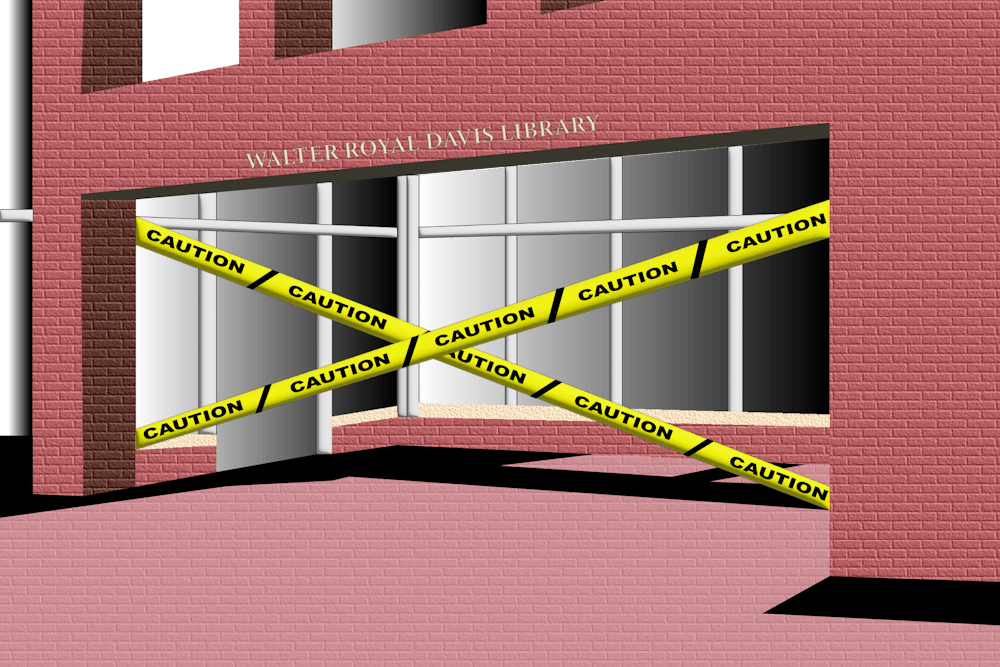On the day before finals each semester just before midnight, hundreds of students congregate in the Davis Library. Are these industrious scholars sharpening their minds with the wealth of knowledge contained in this bastion of learning? No. They are gathered to witness their peers sprint down from the top floor of the library, touch the flagpole in the middle of Polk Place and return, triumphant. They are gathered to witness the Davis streak in a beautiful display of tomfoolery.
The Davis streak is an age-old shenanigan, dating back to the 1970s, when the first string of students chose to lay their feelings bare to the University. Within the current surveillance state of the University and a society which constantly prioritizes productivity and conformity, these sorts of shenanigans can be a form of “good trouble” that express dissatisfaction with an oppressive norm in a nonviolent, visually compelling way.
School is undeniably a priority for all students, but maintaining perspective and embracing the college experience is equally important. When we resist the norms that govern our daily student life, we can reclaim a sense of humor that is all too unfamiliar in the throes of the adult American workforce. This lively pushback, within reason, acts as a conduit whereby we can skirt the suffocation of the day-to-day rat race — and it's something fully embodied in the Davis streak.
However, the streak is not without controversy — on April 14, a letter from UNC’s interim Director of Access Services Suchi Mohanty announced a seemingly permanent end to this good-trouble shenanigan. She said the Davis streak impedes on students’ ability to study on a reading day, threatens the safety of students and staff and creates “thousands of dollars of damage each year.” To prevent the streak from taking place this year, the seventh and eighth floors of Davis Library will be closed and guarded by "dedicated personnel" at 10 p.m. One Cards will be required to enter the library after 10 p.m. and at least through the end of exams. It seems that the upwards of 50 years of stripped-down tomfoolery has come to an end.
With the Davis streak being such an important pillar of Carolina culture, there should have first been attempts at alternative measures that could protect the sacred practice while also ensuring the safety of campus property and people. A more collaborative solution, in which students volunteer to clean up post-streak, could be a viable way to protect this tradition without making others pay for it. Instead, the desire to change the streak was not communicated to students, leaving us in the dark about an event we've done for half a century and further showing the University's distrust of its students.
To shut down this practice is to wholly disregard what it symbolizes. On the cusp of finals week, under crushing academic pressure, we congregate to celebrate an act of joyful defiance. The University justifies prohibiting the streak by noting “numerous safety issues, property damage and a great deal of disruption to students who need to study.” There’s merit to instituting policies minimizing property damages, especially Davis’s beloved books, but eliminating the streak overall is a net negative.
Outside the safety bubble of a college campus, we must continue to cultivate third spaces where we can find community rather than just stumble upon, like where hundreds of our peers share the joy of something that would warrant an arrest for indecent exposure anywhere else.
The Davis streak, once mainly light-hearted, now has been assigned as an act of resistance by the University's ban. We must remember the importance of taking advantage of the community we have at UNC and forming memories through unconventional actions. At their core, shenanigans like the Davis streak are a reminder to balance the rigor of University coursework with a spirited and unified activity regardless of political and institutional undertones. Our unique traditions of buffoonery are things we must strive to protect.




